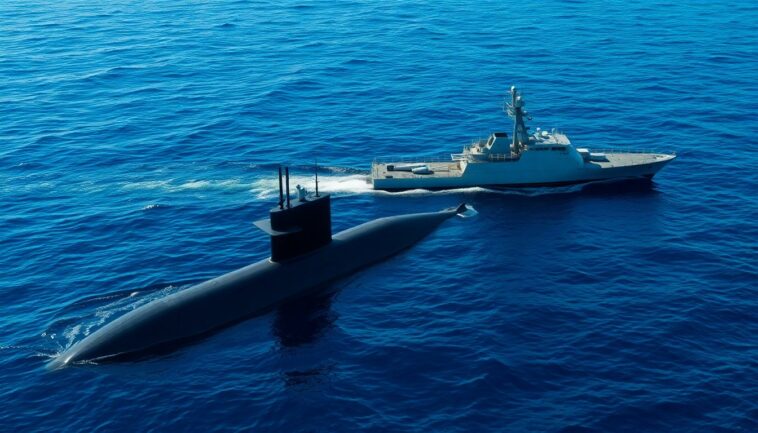For over a century, submarines have served as the ultimate hideaways for those seeking anonymity beneath the waves. From the stealthy U-boats of World War I to the advanced nuclear submarines navigating the depths today, the essence of submarine operation has always revolved around stealth. However, a significant transformation is underway as technological advancements challenge the invisibility of these underwater giants.
One of the fundamental principles of underwater detection lies in the behavior of sound.
In aquatic environments, sound waves travel with greater speed and over longer distances than light or radar signals. This characteristic positions sound as the most effective means of identifying submerged objects. Consequently, modern anti-submarine warfare (ASW) has turned into a strategic game of listening and tracking.
The shift towards new detection technologies
Recent innovations in artificial intelligence (AI), sensor technologies, and autonomous vehicles are fundamentally altering the landscape of submarine detection.
The once exclusive reliance on acoustic methods is now complemented by non-acoustic technologies that can discern the effects of submarines rather than simply their noise. For instance, satellites equipped with synthetic aperture radar can reveal subtle surface disturbances and temperature variations resulting from underwater movements.
Quantum magnetometry and advanced sensors
Traditionally, magnetometers used in ASW were limited by their physical constraints and sensitivity. These devices could only effectively operate at low altitudes and short ranges.
However, the emergence of quantum magnetometers harnesses the principles of quantum mechanics, promising significant improvements in sensitivity. With these advancements, it becomes feasible to detect a submarine’s steel hull from tens of kilometers away, particularly when deployed in swarms aboard uncrewed aerial vehicles or surface vessels.
Autonomous vehicles: The new eyes of the sea
At the forefront of the ASW revolution are uncrewed surface vehicles (USVs). These autonomous crafts range from small, energy-efficient designs to large vessels capable of extended missions at sea.
Unlike traditional crewed ships, USVs can be produced at lower costs and in greater numbers. Equipped with sonar, radar, magnetometers, and communication systems, they form a dynamic sensor network that can adapt and respond in real-time.
For instance, the U.S. Navy’s Sea Hunter, a self-operating trimaran, has demonstrated its capacity to track a diesel-electric submarine for extended periods without human oversight. Similarly, the Royal Navy’s Cetus project is exploring the potential of uncrewed fleets to enhance maritime security.
The role of AI in detection
The integration of AI into ASW is transforming traditional methods. A single USV may only cover a limited area, but a coordinated swarm of hundreds can communicate and share information seamlessly. AI can analyze data from various sources, creating a comprehensive operational picture. For instance, a singular acoustic anomaly might provide little insight, but when combined with additional data points, it could lead to a high-confidence detection.
Moreover, AI’s ability to operate continuously without fatigue is crucial in the relentless pursuit of submarines designed for silent operation. By understanding the navigation patterns of submarines and their methods for avoiding detection, AI algorithms can predict their movements, shifting ASW from a reactive to a proactive stance akin to how meteorology has progressed from mere observation to precise forecasting.
Human oversight and future developments
Despite the increasing capabilities of AI, human operators will remain integral to the ASW process. However, their roles are evolving from direct detection to strategic oversight and trust management, ensuring that decision-makers comprehend AI’s recommendations and rationale. This shift emphasizes the necessity for explainable AI, systems that clarify their decision-making processes and allow for human intervention when necessary.
By the 2030s, the oceans may become as transparent to sensors as the skies became to radar technology in the previous century. With the assistance of AI, an array of transmitters and receivers positioned on ships, aircraft, and USVs will enable real-time triangulation of submarine locations. Additionally, swarms of autonomous underwater vehicles can operate near shorelines to relay crucial data, while satellites can identify anomalies for local sensor networks to investigate.
While the ambition of this vision is impressive, the ocean’s complexity presents significant challenges. Factors such as temperature fluctuations, salinity variations, and seabed topography all contribute to signal distortion and complicate detection algorithms. However, continuous enhancements in AI modeling and computational power are gradually overcoming these hurdles.
As detection technologies advance, submarines will inevitably adapt. Future designs may utilize specialized propulsion systems and materials that minimize thermal and acoustic signatures, while decoy drones could be employed to mislead detection systems. Analysts predict that submarines might operate at greater depths and slower speeds to elude comprehensive surveillance.
In summary, the strategic implications of this technological evolution are profound. Submarines have historically played a vital role in nuclear deterrence and covert power projection. The potential for enhanced transparency due to AI could foster greater stability by reducing the temptation for surprise attacks, or conversely, it could lead to increased instability as nations strive to maintain secrecy.
Ultimately, while submarines will remain powerful assets, they will no longer operate in complete obscurity. The ocean, once a sanctuary for secrecy, is gradually becoming observable to the advancing eyes of technology.



